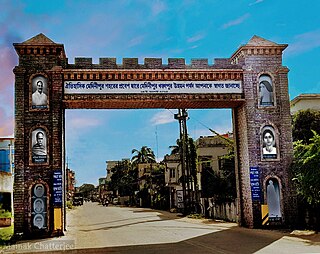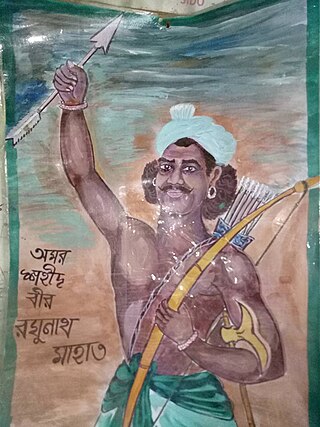
Medinipur or Midnapore is a city known for its history in the Indian state of West Bengal. It is the headquarters of the West Medinipur district. It is situated on the banks of the Kangsabati River. The Urban Agglomeration of Midnapore consists of the city proper, Mohanpur, Keranichati and Khayerullachak. Midnapore and its neighbouring city of Kharagpur constitute the central core of the Midnapore Kharagpur Development Authority metro area, spread across 576 square kilometres.

Singhbhum was a district of India during the British Raj, part of the Chota Nagpur Division of the Bengal Presidency. It was located in the present-day Indian state of Jharkhand. Chaibasa was the district headquarters. Located in the southern limit of the Chota Nagpur Plateau, Singhbhum included the Kolhan estate located in its southeastern part. The district has been segmented into two smaller districts, East Singhbhum and West Singhbhum.
Jhargram is a planned city and a municipality in the Indian state of West Bengal. It is the headquarters of the Jhargram district. It is a popular tourist destination known for its forests, ancient temples and royal palaces.

Jhansi Fort or Jhansi ka Qila is a fortress situated on a large hilltop called Bangira, in Uttar Pradesh. It served as a stronghold of the Chandela Kings in Balwant Nagar from the 11th through the 17th century.

History of Bankura district refers to the history of the present Bankura district in the Indian state of West Bengal.

Bhumij is a Munda ethnic group of India. They primarily live in the Indian states of West Bengal, Odisha, Assam and Jharkhand, mostly in the old Singhbhum district. Also in states like Bihar and Assam. There is also a sizeable population found in Bangladesh. Bhumijas speak the Bhumij language, an Austroasiatic language, and use Ol Onal script for writing.
Chuar rebellion or Chuar revolt, also known as Jungle Mahal movement was a series of peasant movements between 1771 and 1809 by the tribal inhabitants of the countryside surrounding the Jungle Mahals settlements of Dhalbhum, Midnapore, Bankura and Manbhum against the rule of the East India Company (EIC).
Below is given a chronological record of tribal and peasant revolts in India before independence from British rule in the 1947. The list covers those tribal uprisings that occurred during the period of British rule in India.
The Kudmi Mahato are a tribal community in the states of Jharkhand, West Bengal and Odisha of India. They are primarily agriculturalist.

Narajole is a village and gram panchayat in Daspur I CD Block in Ghatal subdivision of Paschim Medinipur district in the state of West Bengal, India.
Gongoni Danga is a natural canyon situated near the town of Garbeta, in the Paschim Medinipur district of West Bengal, India.

Raghunath Mahato was an Indian revolutionary, one of the main leaders of the Chuar Rebellion from the Mahato community. He led a revolt against the East India Company in 1769.
Karnagarh is a village and a gram panchayat in the Salboni CD block in the Medinipur Sadar subdivision of the Paschim Medinipur district in the state of West Bengal, India.
The Narajole Raj was a medieval royal dynasty and later a zamindari (estate) during the British period at Narajole in Paschim Medinipur district in the state of West Bengal. The Raja of Narajole was one of the largest landholders in Midnapore. The kings of Narajole belonged to the Sadgope community and had a close link with the rulers of Karnagarh.

The Midnapore Raj or Karnagarh Raj was medieval dynasty and later a zamindari estate of Sadgop during the British period in the Paschim Medinipur district in the state of West Bengal, India. The semi - independent Rajas of Karnagarh were amongst the most powerful rulers of Jungle Mahal region.
The Bhumij Rebellion or Bhumij Revolt, also known as Ganga Narain's Hungama was a revolt during 1832–1833 by Bhumij tribals based in the Dhalbhum and Jungle Mahal areas of the Midnapore district of the erstwhile Bengal state. It was led by Ganga Narayan Singh.
Durjan Singh was a great leader of Chuar Rebellion of Bengal. Singh was a zamindar of Raipur in Bengal. He led the Chuar Rebellion in 1798–99 in Midnapore district against the British East India Company.

Ganga Narayan Singh was an Indian revolutionary from Jungle Mahals, known as the leader of Bhumij rebellion. He led a revolt against the East India Company in 1832-33. The British called it "Ganga Narain's Hungama", while some historians have called it the Chuar rebellion.










